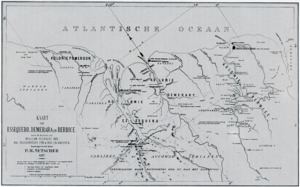Date 22 January 1782 | ||
 | ||
Results French victory,, French occupation of Demerara, Essequibo and Berbice until the Treaty of Paris (1783) Similar Battle of the Mona Passage, Invasion of Tobago, Battle of Martinique, Capture of St Lucia, Battle of Providien | ||
Capture of demerara and essequibo
The Capture of Demerara and Essequibo was a French military expedition sent in January 1782 as part of the Anglo-French War. In 1781, Admiral Lord Rodney sent two sloops from his fleet at Sint Eustatius to take possession of the Dutch colonies of Essequibo and Demerara. In 1782, the French successfully took possession of these settlements, compelling British Governor Robert Kinston to surrender. The peace of Paris, which occurred in 1783, restored these territories to the Dutch.
Contents
Background
In December 1781, Great Britain declared war on the Dutch Republic, bringing it formally into the 4th Anglo-Dutch War. In early 1781, a large British fleet, under Admiral Lord Rodney, was sent to the West Indies. After having made some seizures in the Caribbean Islands, Rodney sent two sloops to take possession of the colonies of Essequebo and Demerara, which they accomplished without much difficulty. The colonies had already de facto surrendered to six British privateer ships by the time the two naval vessels arrived. The governor, Van Schuilenburg, was not satisfied by Dutch protection and surrendered to the British, who found a rich booty in the colonies. The vast quantity of produce which had accumulated due to a lack of shipping proved to be of great value.
French capture
French naval Captain Armand Guy Simon de Coëtnempren, Comte de Kersaint, with his 32-gun flagship Iphigénie and four lesser ships arrived at Demerara without much opposition. France's 335 men from the Regiment Armagnac and the 1st Legion Volontaires étranger de la Marine, launched an assault toward the British garrison and compelled Gov. Robert Kinston and his detachment from the 28th Regiment of Foot to surrender. As a result, Essequebo and Berbice also surrendered to the French on 1 and 5 February.
The French seized five Royal Navy vessels: the 20-gun Orinoque (Commander William Tahourdin), 16-gun Barbuda (Commander Francis Pender), 18-gun Sylph (Commander Lawrence Graeme), 16-gun Stormont (Commander Christmas Paul), and 16-gun brig Rodney (Lieutenant John Douglas Brisbane).
Aftermath
The Count de Kersaint became governor of the three rivers and their settlements and inhabitants. To guarantee their conquest, the French began to erect forts at the mouth of the Demerara River — one on its eastern, the other on its western bank — and for that purpose compelled the planters to furnish slave labor. They also doubled the capitation tax. These burdens were felt severely by the colonists. The peace of Paris, which occurred in 1783, restored these territories to the Dutch. When Demerara surrendered to the French, the British naval commander being at that place signed the capitulation. Gov. Kingston's proposals for terms contained the following rather singular proposition:
To this the following answer was returned:
